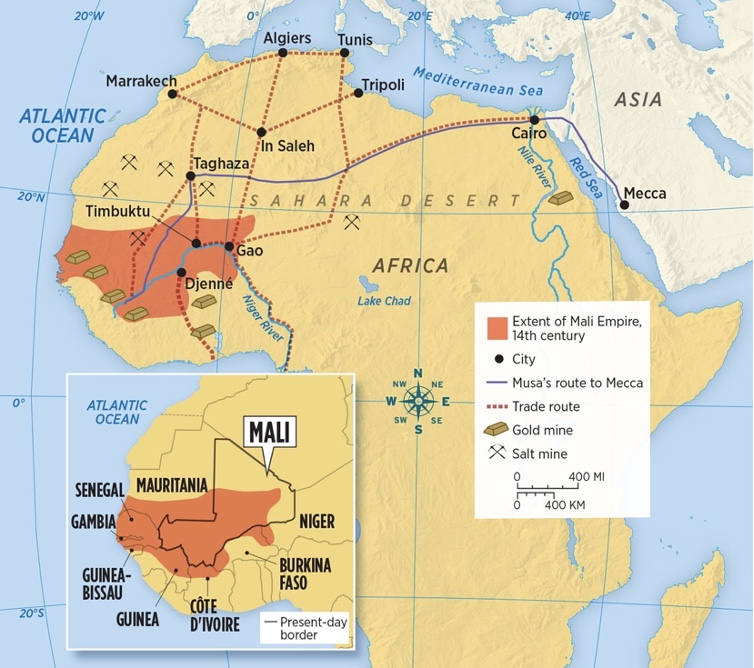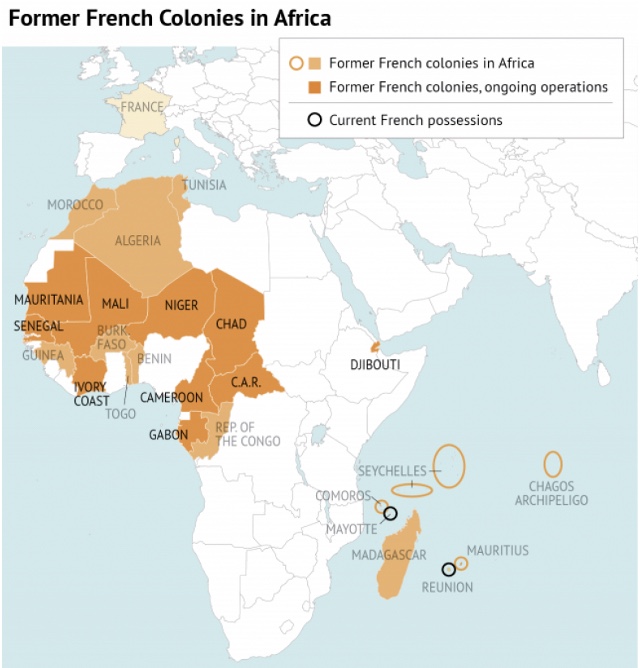
One may assume that wealth provides abundant resources that can be readily accessed for generations. However, when well-resourced countries are subject to exploitation and colonialism, economic prosperity is short-lived. Instead, poverty is passed down as a legacy while generational wealth is all but a distant dream. Although Mali and its inhabitants are extremely impoverished in today’s global economy, there was once a time when the Mali Empire was synonymous with wealth, overflowing with gold, salt and ivory. This raises the question: How does a country shift from being part of one of the most resourceful and wealthiest empires to being on the cusp of inextricable poverty, struggling with lack of education and malnutrition?
Streams of Gold
In keeping with the Marxist perspective on economic dynamism, “poverty does not just exist, it is created” (Hickel, 23). Poverty emerges as a result of states accumulating wealth and influence through the exploitation of resources and misuse of power over other countries. Thus, the swift ascent of the Mali Empire to economic success and its subsequent decline serves as a case study to further conceptualize the inevitability of poverty emerging as wealth is accrued.
During the 13th century, Mali accrued its wealth under the skillful leadership of Mansa Musa I and was the center of African trade. Its proximity to the Niger River allowed the Mali Empire to capitalize on the trading of gold, copper, salt and ivory across West Africa. During this time, Mali played an integral role in the global supply chain producing more than half of the world’s supply of gold and salt (Braga, 2021). Furthermore, Mali’s geographic location gave the empire complete control of the Trans-Saharan Trade Routes which allowed them to monopolize gold trade. In addition to leveraging their access to the abundance of natural resources that their territory provided, Malian rulers like Mansa Musa, used the exploitive tactics of over-taxing and increasing retail prices of traded goods to secure and sustain Mali’s wealth (Braga, 2021).
Poverty does not just exist, it is created.
Jason Hickel

Not All That Glitters
At the time of his passing, in 1337, Mansa Musa’s net worth was estimated at $400 billion USD in today’s currency, making him the richest man to have ever lived (Davidson, 2015). He also left an illustrious legacy of wealth to the Malian Empire, having placed a strong emphasis on education and innovation during his tenure. Mansa Musa charted the first university in the world to be built in the city of Timbuktu (Braga, 2021). Not only was Mali producing more than 80% of the world’s supply of gold during the 14th century, but Timbukto became the scientific hub for students interested in studying medicine, chemistry, astrology, and art. The Mali Empire was undoubtedly thriving, but the kingdom’s decline was much quicker than its ascent up the economic ladder. With such a rich historical background one would think that the rulers who reigned after Mansa Musa would try to maintain the wealth that he secured. However, shortly after Mansa Musa’s passing the empire began to decline due to poor leadership and subsequent civic unrest.
Mansa’s successors struggled to maintain the legacy that he had built as the Empire was too vast for them to manage. As a result, Mali began to swiftly lose control of its territory and its monopolization on gold trade. No longer being able to leverage its location and natural resources, the Empire ultimately lost its economic and political relevance in the global economy (Britannica, 2021). To make matters worse, European countries quickly began gaining economic traction through widespread colonization of West African countries, which facilitated the opening of other trade routes (Cartwright, 2019). Similar to the economic tactics that Mansa Musa once used, European countries, like France and Portugal, began using exploitive strategies, such as over-taxing extracted resources, to gain its wealth. Thus, the combination of poor leadership and European colonization primarily contributed to the swift downfall of the Mali Empire (Boddy-Evans, 2020). Mali’s decline is one of many examples that further support that poverty is created. The abasement of the Mali Empire portrays the volatility that is inherent to wealth and poverty, as the two are inversely related. While Mali has proven that economic exploitation is difficult to overcome, as they are still grappling with widespread poverty, the Empire’s history reveals a fundamental truth; wealth exists because poverty exists.

This Too Shall Pass
One might grapple with the juxtaposition between the elaborate wealth that the empire once enjoyed and the current humanitarian crisis that Mali is struggling with due to its economic state. In 2011, the United States Agency of International Development (USAID) reported that 50.3% of the Malian population lived on less than $1.90 USD. Additionally, the country had an adult literacy rate of only 35.47%, and only 19.92% of the population had access to sanitary facilities and clean drinking water. These statistics simply give numerical weight to the fact that the wealth that the Mali Empire once experienced is long gone and was replaced by inextricable poverty and civic unrest.
A Light at the End
Given the state of Mali’s economy, there have been several initiatives created by foreign agencies, non-profits and think tanks aimed at eradicating poverty in Mali (Ratté, 2021). After recording such staggering data, the USAID has implemented educational, environmental and agricultural programs to offset the economic strains with which the country is grappling. For example, an agricultural project in 2018 that provide 404,000 Malian farmers with innovative farming techniques that would improve their production rates. Additionally, through the U.S government’s global hunger and food initiative, there has been increased attention on the reduction of food insecurity by assessing technologically advanced mechanisms that could be implemented in the agricultural sector in Mali as of 2016.
While Mali may be on the cusp of inextricable poverty, we have seen history take drastic shifts, against all odds. However, with the strategic creation of poverty in Africa due to colonialism and exploitation, it may be difficult for countries like Mali to be restored to its former glory. The tragic truth about the creation of poverty is that it is usually upheld by inbred systems of oppression which makes it difficult for countries like Mali to overcome its state of destitution. Colonialism has crippled the economies of dependent states so much so that although the practice is antiquated, poverty seems to recreate itself within these regions. Even worse, lack of education and disunity makes it highly unlikely that Malian citizens will work towards the common goal of restoring the nation’s wealth, thus creating a never-ending cycle of underdevelopment.
We can always hope that one day Mali will experience economic stability but more importantly, the rise and fall of the Mali Empire should cause us to assess what it means to be wealthy and how we contribute to the creation of poverty in our daily lives.
Reference List
Anastasia L. Mansa Musa: The 400-Billion-Dollar Man. The New York Times Upfront. https://upfront-aem64-dev.scholastic.com/issues/2018-19/021819/mansa-musa-the-400-billion-dollar-man.html. Published February 18, 2018. Accessed April 11, 2022.
Braga, Brunno. Did you know? West Africa’s Mali was one of the richest places in the world. Travel Noire. https://travelnoire.com/west-africas-mali-was-richest-place-in-world. Published August 25, 2021. Accessed April 8, 2022.
Britannica, T. Editors of Encyclopaedia (2021, September 5). Mali. Encyclopedia Britannica. https://www.britannica.com/place/Mali-historical-empire-Africa
Boddy-Evans, A. (2020, January 31). Overview of Mali History and Independence. ThoughtCo. Retrieved May 5, 2022, from https://www.thoughtco.com/brief-history-of-mali-44272
Cartwright, M. (2019, March 1). Mali Empire. World History Encyclopedia. Retrieved May 5, 2022, from https://www.worldhistory.org/Mali_Empire/
Davidson, Jacob. The 10 richest people of all time. Money. https://money.com/the-10-richest-people-of-all-time-2/. Published July 30, 2015. Accessed April 11, 2022.
Hickel J. The Divide: Global Inequality from Conquest to Free Markets. New York: W.W. Norton & Company; 2018.
Mali Country Profile. IDEA: International Data & Economic Analysis. https://idea.usaid.gov/cd/mali/hunger-and-food-security. Published October 2021. Accessed April 11, 2022.
Map of Former French Colonies. Stratfor Worldview. (n.d.). Retrieved May 5, 2022, from https://worldview.stratfor.com/search?q=French+AND+colonies
Peet, Richard. Inequality and poverty: A Marxist-geographic theory∗. Annals of the Association of American Geographers. 1975;65(4):564-571. doi:10.1111/j.1467-8306.1975.tb01063.x
Ratté Leo. The fight against poverty in Mali. The Borgen Project. https://borgenproject.org/fight-against-poverty-in-mali/. Published May 3, 2021. Accessed April 11, 2022.
The following post describes the rise of the Mali Empire due to its capitalization on natural resources , such as gold, and the subsequent exploitation that led to its decline.